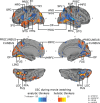A drama movie activates brains of holistic and analytical thinkers differentially
- PMID: 30418656
- PMCID: PMC6277741
- DOI: 10.1093/scan/nsy099
A drama movie activates brains of holistic and analytical thinkers differentially
Abstract
People socialized in different cultures differ in their thinking styles. Eastern-culture people view objects more holistically by taking context into account, whereas Western-culture people view objects more analytically by focusing on them at the expense of context. Here we studied whether participants, who have different thinking styles but live within the same culture, exhibit differential brain activity when viewing a drama movie. A total of 26 Finnish participants, who were divided into holistic and analytical thinkers based on self-report questionnaire scores, watched a shortened drama movie during functional magnetic resonance imaging. We compared intersubject correlation (ISC) of brain hemodynamic activity of holistic vs analytical participants across the movie viewings. Holistic thinkers showed significant ISC in more extensive cortical areas than analytical thinkers, suggesting that they perceived the movie in a more similar fashion. Significantly higher ISC was observed in holistic thinkers in occipital, prefrontal and temporal cortices. In analytical thinkers, significant ISC was observed in right-hemisphere fusiform gyrus, temporoparietal junction and frontal cortex. Since these results were obtained in participants with similar cultural background, they are less prone to confounds by other possible cultural differences. Overall, our results show how brain activity in holistic vs analytical participants differs when viewing the same drama movie.
Figures





References
-
- Atique B., Erb M., Gharabaghi A., et al. (2011). Task-specific activity and connectivity within the mentalizing network during emotion and intention mentalizing. NeuroImage, 55, 1899–911. - PubMed
-
- Baranski J.V., Petrusic W.M. (1999). Realism of confidence in sensory discrimination. Perception and Psychophysics, 61, 1369–83. - PubMed
-
- Bernhardt B.C., Singer T. (2012). The neural basis of empathy. Annu Rev Neurosci., 35, 1–23. - PubMed

